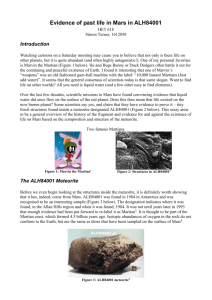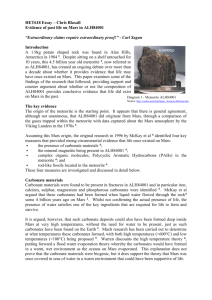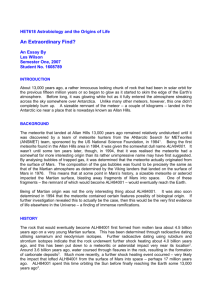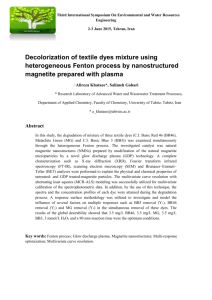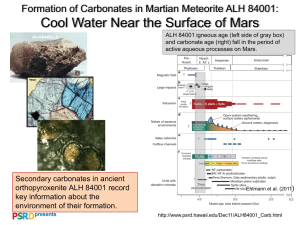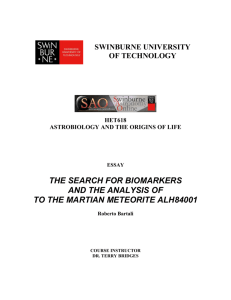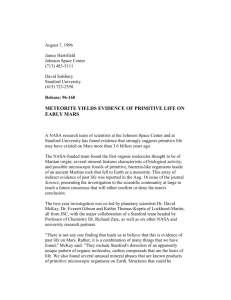Essay-HET618_ZviGree..
advertisement
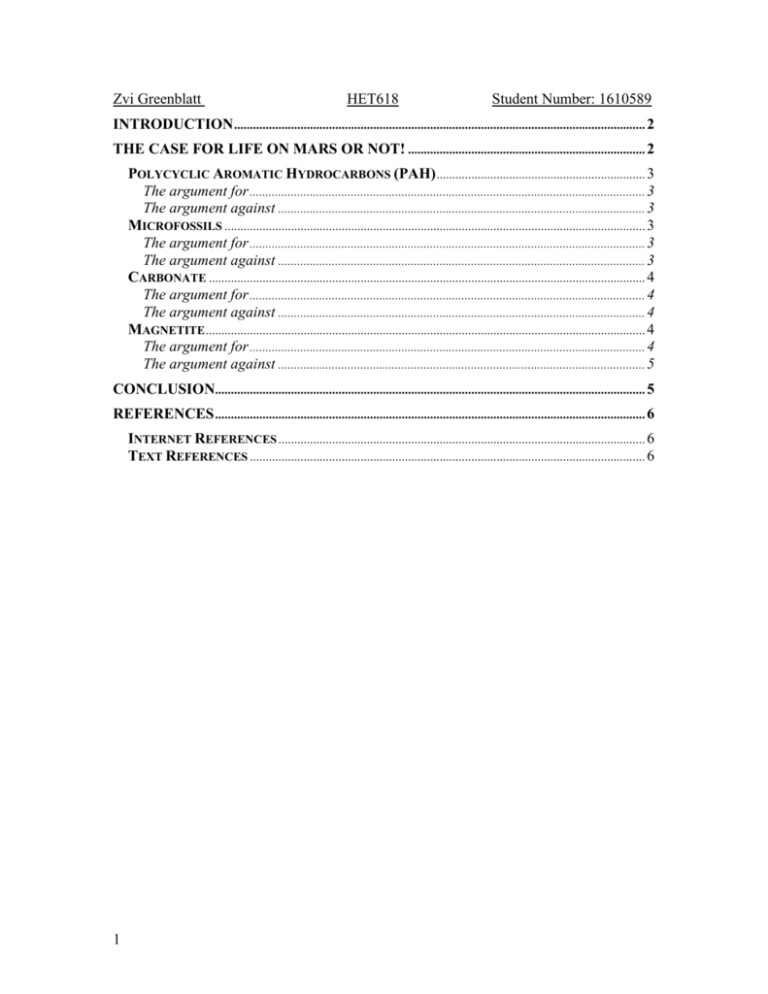
Zvi Greenblatt HET618 Student Number: 1610589 INTRODUCTION .................................................................................................................................. 2 THE CASE FOR LIFE ON MARS OR NOT! ........................................................................... 2 POLYCYCLIC AROMATIC HYDROCARBONS (PAH) .................................................................. 3 The argument for ............................................................................................................................. 3 The argument against .................................................................................................................... 3 MICROFOSSILS ..................................................................................................................................... 3 The argument for ............................................................................................................................. 3 The argument against .................................................................................................................... 3 CARBONATE .......................................................................................................................................... 4 The argument for ............................................................................................................................. 4 The argument against .................................................................................................................... 4 MAGNETITE ........................................................................................................................................... 4 The argument for ............................................................................................................................. 4 The argument against .................................................................................................................... 5 CONCLUSION........................................................................................................................................ 5 REFERENCES ........................................................................................................................................ 6 INTERNET REFERENCES .................................................................................................................... 6 TEXT REFERENCES ............................................................................................................................. 6 1 “Sober Creator or Creators Bore” INTRODUCTION It must have been a cold day, that 27th December 1984, for even though it was midsummer, the mean summer temperature in Antarctica is rarely warmer than -15ºC and had been recorded as low as -35ºC (WEAWEB). Obviously, undaunted by the cold, US geologist Roberta Score, hunting for meteorites in the Alan Hills region, noticed a greenish-gray rock against the icy glacial plains and which by its color, she knew was unique (DISWEB). As the first ‘find’ of the 1984 season, the rock was labeled ALH84001. Initially, misclassified, the rock languished for ten years until correctly identified as being Martian in origin (MISWEB). A further two years passed while it was subjected to detailed analysis. The results of the analysis were designed to be earthshattering in nature and to ensure a maximum audience, the message was further carried by President Clinton, that NASA scientists had found evidence that strongly suggested that primitive life may have existed on Mars more than 3.6 billion years ago (DATWEB, CLIWEB). This essay will briefly examine the four major assertions made by the discovery scientists and list the main points and counterpoints for each of the assertions. I will examine in more detail the assertion that the grains of the mineral magnetite, were produced by magnetotactic bacteria and provide the arguments that disprove this assertion. As Carl Sagan once said: “Extraordinary claims, require extraordinary evidence” (Raeburn, P. pg.184), and these words were echoed by J. William Schopf, who although invited to the NASA press conference on the discovery, did not share all the views of the NASA scientists. We have certainly been exposed to an extraordinary claim, but the extraordinary evidence has not been forthcoming. THE CASE FOR LIFE ON MARS OR NOT! NASA scientists, led by David McKay presented four arguments supporting their claim that Mars once harbored life. These are: 1. Chemical analysis showed that the meteorite contained a number of organic molecules known as Polycyclic Aromatic Hydrocarbons (PAH), which are known to be produced by biological processes. 2. Structures were identified within the meteorite which looked remarkably like, albeit much smaller than Earth-like bacteria. 3. The carbonate minerals have a structure and chemistry that suggest that they may have been formed with the assistance of primitive, bacteria-like living organisms. 4. Magnetite, a magnetic mineral known to be produced in some Earth based bacteria, which then align the crystals to form microscopic compasses, was found in ALH84001. 2 Polycyclic Aromatic Hydrocarbons (PAH) The argument for Complex organic molecules or PAHs are present in ALH84001. PAHs occur naturally on Earth and form when living organisms die and decay, thereby creating the hydrocarbons associated with coal and oil (Knoll A.H. pg.22, Gibson E 1997. pg.10). PAHs were found deep inside the meteorite, where contamination is very unlikely (Gibson E 1997. pg.11). Furthermore, terrestrial PAHs were not found in great concentrations in Antarctic ice and as they are characterized by their own unique ‘fingerprints’, very different from those found in ALH84001, this further mitigated the chances of contamination (Gibson E 2001. pg.19). The argument against PAHs have also been found in Carbonaceous meteorites which formed in the outer solar system. This means that biological processes are not necessary for their formation (Knoll A.H. pg.23). During the 13000 years that ALH84001 has been on Earth (Gibson E. 1997 pg.6, McKay D 1996. pg.924), meltwater from countless freeze and thaw cycles could have permeated the rock, contamination could have occurred. In January 1998, it was shown that terrestrial amino acids had been found in ALH84001, thereby confirming contamination by groundwater. When a much younger Martian meteorite, known to have formed long after liquid water had ceased to flow, leaving Mars lifeless, showed a similar set of PAHs to those found in ALH84001, researchers concluded that these PAHs came from non-biological sources (Knoll A.H. pg.23). Microfossils The argument for The discovery-scientists describe structures that look remarkably similar to simple bacterial cells, except for the fact that they are very small when compared to terrestrial bacteria by a factor of 10. Arguing that not enough work has been done in determining the lower size of terrestrial bacteria, support has come from scientists worldwide who are undertaking various studies to determine that bacteria of this size are viable (Knoll A.H. pg.23, Gibson E. 1997 pg.12, Gibson E 2001. pg.22). The argument against Simple one celled terrestrial organisms are made up of millions of molecules, while the microfossils are made up of ‘a handful’, thus calling into question the idea that so few molecules can actually possess the ability to sustain life. In 1998, a National Research Council panel concluded that the so-called microfossils were “100 to 1000 times too small to be free-living organisms because they couldn’t have held all the proteins, DNA and other molecules necessary for even the simplest metabolic processes” (SETWEB). Knoll also notes that the treatment processes that samples undergo prior to scanning by an electron microscope, can alter, accentuate or even create the appearances of the objects (Knoll A.H. pg.23, McKay D 1996. pg.928). The so-called microfossils could also have been formed by aqueous corrosion on the mineral surfaces of ALH84001 during its 13000 year exposure to Antarctic ice. It has 3 also been reported that some of the elongated structures “resemble the emergent plate edges of pyroxene” (Gibson E 2001. pg.23). Carbonate The argument for ALH84001 was found to contain tiny globules of calcium carbonate, which is the main constituent of limestone. The discovery-scientists favored the theory that the carbonate globules could have a biological origin and were deposited by a fluid, which was saturated with carbon dioxide that filtered through the rock fractures. Additionally, they presented evidence that the carbonates formed at temperatures below 100ºC by analysis of the distribution of the oxygen isotopes in the carbonates (Gibson E 1997. pg.8, Gibson E 2001. pg.16). The argument concerning contamination on Earth, was countered by detailed separate analyses of the carbonate globules themselves, which showed no evidence of contamination (Raeburn, P. pg.184-185, 188). The argument against Schopf argues that the globules could have formed by some physical process at a very high temperature (400ºC-600ºC) during the impact that blasted the rock from Mars. That would mean that any life in the rock would have been destroyed (Raeburn, P. pg.184). The high temperature formation model, is also shared by Bradley, McSween, Harvey and Scott (Gibson E 2001. pg.17). This was found by close examination of carbonaceous components of unknown origin with δC13 values and isotopic studies of carbon content consistent with high temperature combustion models (Becker L 1999. pg.72). Additionally, Carbonate minerals are known to form deep in the Earth at many hundred ºC in circumstances that no biological influence is possible or apparent. When all the evidence is summed up, Knoll summarizes the case for carbon quite well when he states, “…the only valid conclusion is that the carbon precipitates are consistent with the presence of life – not that they require it” (Knoll A.H. pg.22). Magnetite The argument for I am of the opinion that the discovery of magnetite in ALH84001, represents the strongest argument supporting the claim for early life on Mars. As such, I chose to concentrate on this subject in more detail. Magnetite is a naturally found, magnetic mineral made from oxygen and iron (MAGWEB). Magnetite has also been found in the brains (and beaks) of certain animals, (whales, pigeons and salmon), which navigate over large areas. It is presumed that these animals use the magnetite as a natural compass for navigational purposes by picking up the magnetic field of the Earth (SALWEB, WHAWEB, PIGWEB, BEAWEB). Certain bacteria produce extraordinarily small and pure magnetite crystals and then align the magnetic grains for orientation purposes. As some of the magnetite grains in ALH84001 share the shape, small size and remarkable purity of those produced by bacteria on Earth, the discovery-scientists argued that Martian bacteria had produced the magnetite. Additionally, no non-biological process was known that could have formed them (Knoll A.H. pg.22, SETWEB). 4 The basis for the Katie et al. (2000) report, states that the magnetite crystals in ALH84001 are identical to those produced by the marine magnetotactic bacterium strain MV-1 and that there is no known natural terrestrial inorganic mechanism that can explain the magnetite crystals found in MV-1. Supporting evidence comes from the likelihood that Mars had free standing bodies of water, organic and inorganic carbon sources and a magnetic field (Kathie L 2000. pg. 2164). The argument against Although a strong supporter that the magnetite was produced by living matter, L Kathie et al. notes that the so called chains of magnetite which are supposedly the orientation mechanism of the living matter were not observed even though they were observing with a Transmission Electron Microscope (TEM)( Kathie L 2000. pg. 2166, 2168). She explains that when the organisms die, the chains collapse as the magnetosome membrane decomposes and as a result, the magnetite is dispersed. E Gibson et al. reports that the magnetite in ALH84001 is arranged in chains. Considering the technology available, there is not even agreement on this basic point (Gibson E 1997. pg 10). A Knoll points out the magnetite crystals come in various sizes and shapes. This would imply that there were many magnetite producing microorganisms which would imply a diverse and complex environment. Additionally, some of the magnetite shows defects in their crystal structure which are only known to form at many hundreds ºC – way above livable temperatures (Knoll A.H. pg.22). Contrary to L Kathie et al. claims, NASA scientists were able to simulate Martian conditions and create magnetite grains in a non-biological way (inorganically) and also incorporated them into balls of carbonate (SETWEB). Edward Scott and David J. Barber present a powerful case that the magnetite in ALH 84001 formed as a result of impact heating and decomposition of carbonate. Their studies show that “the planes of atoms in the Martian magnetites are aligned with atomic planes in the carbonate in which the magnetites are embedded” (Scott E.R.D et al. 2002. pg.1). This means that the magnetites formed in the rock and not inside micro-organisms. They further argue that if any magnetites with the sizes of the supposedly biogenic variety had been deposited in the ALH 84001 carbonate prior to the impact heating that they could not have retained their original properties as they would have acted as seed crystals during subsequent cooling and would have been coated with new layers of magnetite. The conclusion is that Martian organisms cannot be responsible for the size and shape of any magnetite crystal found in ALH 84001 (Scott E.R.D et al. 2002. pg.1,8). CONCLUSION One may ask then, if ALH8401 does not show primitive life on Mars, what value has mankind received from it considering all the time, money and research efforts that have centered on this little piece of Mars? Certainly, many scientists have been attracted to this field of research and they have forced us to critically examine all our approaches, scientific, moral and philosophical to extraterrestrial samples. Many of the same 5 processes used to discount life forms in ALH84001, will be used to help us answer the age old question: ‘Are we alone?’ As we plan for sample return missions from Mars, we are refining our scientific methods to better understand fossilization processes in anticipation that these samples will give us the key to understanding the origins of life on Earth, Mars and perhaps other planets. Therein lies ALH84001’s value, and it is likely to increase over time. REFERENCES Internet References BEAWEB:http://news.nationalgeographic.com/news/2004/11/1124_041124_magnetic_bi rds.html CLIWEB: http://www.coseti.org/mars_2.htm DATWEB: http://www.spie.org/web/oer/december/dec96/etlife.html DISWEB: http://www.ovpr.uga.edu/researchnews/summer2001/mars.html MISWEB: http://curator.jsc.nasa.gov/antmet/marsmets/samples.cfm MAGWEB: http://www.mindat.org/min-2538.html PIGWEB: http://www.can-do.com/uci/ssi2000/pigeons.html SALWEB: http://jeb.biologists.org/cgi/content/abstract/140/1/51 SETWEB: http://www.seti.nl/article.php?id=2009 WEAWEB: http://www.antarcticconnection.com/antarctic/weather/index.shtml WHAWEB: http://www.afsc.noaa.gov/NMML/education/cetaceans/cetaceastrand.htm Text References Becker, L et al The origin of organic matter in the Martian meteorite ALH84001 in Earth and Planetary Science Letters167, January 1999 Gibson, E.K. et al The Case for Relic Life on Mars in Scientific American,December 1997, Vol.277 Issue 6 Gibson, E.K et al Life on Mars: evaluation of the evidence within Martian meteorites ALH84001, Nakhla, and Shergotty in Precambrian Research 106 (2001), Pages 15 -34 Kathie L.T et al Truncated hexa-octahedral magnetite crystals in ALH84001: Presumptive biosignatures in PNAS Vol. 98 Number 5 February 27th 2001 Knoll, A.H. A Martian Chronicle in The Sciences. July/August 1998, Pages 20 – 26 McKay D.S. et al Search for Past Life on Mars: Possible Relic Biogenic Activity in Martian Meteorite ALH84001 in Science, August 16 1996 Raeburn, P. Uncovering The Secrets Of The Red Planet: Mars 1998. The National Geographic Society. Washington DC 6 Scott E.R.D and Barber D. J Resolution of a Big Argument About Tiny Magnetic Minerals in Martian Meteorite May 13th 2002 downloadable from http://www.psrd.hawaii.edu/May02/PSRD-ALH84001magnetite.pdf Authors note: The words ‘Sober Creator’ and ‘Creators Bore’ are anagrams of ‘Roberta Score’, the discoverer of ALH84001. 7
